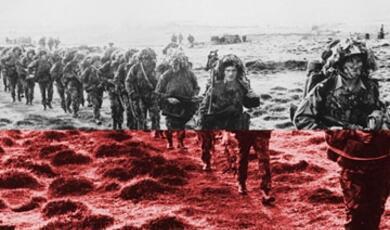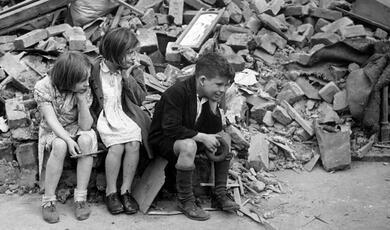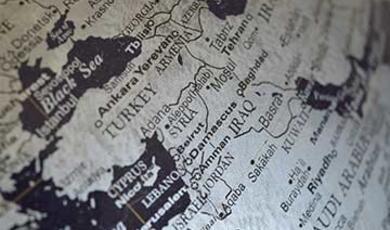4 June 2013
Summit Diplomacy:
Some Lessons From History For 21st Century Leaders
David Reynolds
This is the first of a series of three lectures about history and policy, about the ways in which historians might be able to contribute to current policy debates. Tonight, I am talking about diplomacy; next week, there will be something about environmental policy; and then, thirdly, about development policy, and that is an example of what history and policy is trying to do: link up academic research with issues of current concern in the political arena.
Some lessons from history, “lessons” in quotation marks because, as you will see, I am wary about the use of the term “lessons” or I think at least we have to be clear what history can teach and what it cannot teach…
Here we are, statesmen on the world stage. There is Winston Churchill in Washington in 1941, and there is David Cameron and Barack Obama at the G20 Summit in Toronto, a year or so ago I think – example, the G20, of how summitry has become institutionalised in the last 60 years, and that is something I will get onto in a moment. The idea of a summit meeting is now very much very familiar to us.
There is Time magazine from the 1980s, from 1985, “Let’s Talk”, Reagan and Gorbachev. This summitry is about top level meetings for high stakes.
What I want to suggest to you is that, despite all that media attention about something special to do with summitry, it is rooted in daily life. It is rooted, for example, like having a date, trying to persuade the other person that you are incredibly attractive, interesting, have a great deal to offer. It is rooted in other kinds of daily life activities: a business meeting, for instance, where you are trying to work out agreements with partners; or even something just as basic as trying to sell a used car and not ask too many questions about what is under the bonnet. Summitry involves skills, if that is the word, we use in daily life. It also involves the experiences of daily life or at least of travel: jet lag – jet lag is a fundamental part of summitry because it involves so much air travel to foreign climes. So, summitry draws on skills we use every day, but the fate of nations hangs on the outcome, and that is a point I want to say this evening.
So, what sort of advice do we have from the past about summitry? It is not easy to see how things could be worsened by a parley at the summit. Winston Churchill in 1950 – I think Churchill probably coins the term “summit”, “summit meeting”, “parley at the summit”. Churchill, amongst his many achievements, was a great wordsmith, a wordsmith certainly of diplomacy. I think we can credit him with this term, “summit”. He is certainly the person who popularises the term “Special Relationship”, and also of course the term “Iron Curtain”. All those three are terms that became fundamental to Cold War diplomacy in the second half of the twentieth century, so that is not bad for a leader, aside from all the things he did in 1940, creating part of our diplomatic lexicon. So, it is not easy to see how things could be worsened by a parley at the summit.
John Kennedy at the end of the ‘50s: “It is far better that we should meet at the summit than at the brink.” In other words, at the brink of nuclear war, on the edge of the abyss…
But a different view – these are the views of leaders. Here is the view from a diplomat, Sir Alexander Cadogan, who was Permanent Under-Secretary at the Foreign Office in the Second World War: “It is always the same with these conferences: the great men do not know what they are talking about and have to be educated.” That is the diplomat’s view of all this. The prima donnas again to strut their act on the stage, while the diplomats, the people who really know how to handle these things, have to sort out the mess that they create.
And here is an even more fundamental view from a diplomat of many centuries ago, the fifteenth century: “If great princes have a desire to continue friends, in my judgement, they ought never to meet.”
That, I think, leads me to a rather fundamental point: viewed historically, leaders did not usually engage in direct negotiation; they avoided personal contact, for a variety of reasons.
One was security. This a picture of Rouen in 1419, at a time of chronic instability in France, a summit meeting, if you like, on a small scale, between the Dauphin and one of the feuding barons, Duke John. They meet, warily to begin with, across a wicket gate in the middle of a bridge to converse about the problems. The discussion goes well. Duke John decides that they are going to be able to sort things out. He goes through the wicket gate and is stabbed to death by the Dauphin’s entourage. So, on the whole, great princes avoided meeting because of possible dangers to their own security.
There was also the issue of status: who goes to whom? If you go to somebody else’s court, almost by definition, you are saying “I am subordinate to you – I am inferior to you.” This is a classic example, Canossa in 1077, when the Emperor Henry IV goes to the gates of Canossa, to the papal castle, and, in a sense, is forced to pay homage to the Pope, Gregory VII.
So, security and status were two reasons why you did not meet if you were a leader, and thirdly, bureaucratisation. In the sixteenth/seventeenth century, diplomacy becomes bureaucratised. It is left to the diplomats, to the ambassadors, resident ambassadors in different countries. They handle things. That is the picture of the Foreign Office in London, King Charles Street.
These were all reasons why statesmen did not meet for much of the early modern period. The political leader as a statesman is, I think, an essentially twentieth century idea, and especially it dates from the 1930s, from one of the most unlikely or one of the most denigrated Prime Ministers of the twentieth century in Britain, Neville Chamberlain.
It is made possible, I think, by air travel. You may not be able to make it all out, but what we have here, this is a cartoon in September 1938 when Chamberlain goes to visit Hitler at Berchtesgaden, the first of three meetings. This is Neville Chamberlain taking off, in the top right corner, new diplomacy, and here, we have old diplomacy, horse and cart style, with secret despatches, hush-hush stuff, lots of red tape, and the practitioners of the old diplomacy are appalled at this upstart who is flying off and creating such a fuss. It is worth remembering that when Neville Chamberlain went to see Hitler, those three visits in 1938 in a matter of a fortnight, he was 69. He had flown once before but it was only a joyride round an airfield in Birmingham, one loop. This was a very different thing: four hours in a really rather precarious flight to see the German dictator, to try and talk man-to-man about the issues of war and peace, because Chamberlain believed that diplomacy now was too important to be left to the diplomats, too important to be left to the diplomats because of the issue of what we would now call weapons of mass destruction. That is my second point: modern summitry is made possible by air travel, the fact that Chamberlain can fly to Berchtesgaden in four hours. When Disraeli went to Berlin in 1878, it took him four days, by train. So, it is made possible by air travel; it is made necessary by weapons of mass destruction, as we would now call them.
For Chamberlain, it is the bomber – it is the threat to this country, the unprecedented threat of airborne destruction that makes the English Channel no longer a barrier, in the air age, to the aggressor. For much of British history, the Channel, though it is only twenty miles across, 21 miles wide, is what Shakespeare called our “moat defensive”. It provided a reasonable barrier against aggressor: Philip II of Spain, the Armada, in 1588; Napoleon, at the beginning of the nineteenth century. That is no longer the case in the era of air power. One of the most moving documents of 1938, I think, is the record in the Cabinet Minutes of Neville Chamberlain, after his second visit to Hitler, flying back, as he told his Cabinet colleagues, up the Thames, on a beautiful evening, rather like this one, and looking down over what was then the Docks, over Woolwich and Deptford and the East End, looking at rows upon rows of little terraced houses, and asking himself what he could do to save those people from massive destruction. Remember that, in 1938, they imagined bombing is going to have the effect that in the 1960s people thought nuclear war would have: in other words, huge destruction, thousands and thousands and thousands of deaths in the first 24 hours. So, that is a serious issue for a leader. Summitry is made necessary by weapons of mass destruction.
This from 1961, Kennedy and Khrushchev, and you can see they are arm-wrestling, the American leader and the Soviet leader, sitting on top of nuclear weapons. That is the issue that is now threatening the peace of the world.
So, made possible by air travel, made necessary by weapons of mass destruction, and made into household news by the mass media – that is the third ingredient I think of twentieth century summitry.
Here is Reagan and Gorbachev at Geneva in 1985, and you can see around there a battery of cameras, of the press, of the television and so on, recording what goes on and broadcasting it all over the world.
So, twentieth century summitry, as I spent some time arguing in this book that Valerie mentioned, “Summits”, is very much a product of those three issues: made possible by air travel; made necessary by weapons of mass destruction; made into household news by the mass media.
How have we moved on from that into the present day? Well, it seems to me that, since the Cold War, there are fewer opportunities for dramatic personal interventions of the sort that Chamberlain imagined he was doing in ’38, that Kennedy and Khrushchev engaged in, Reagan and Gorbachev. Summitry has become slightly different, for a number of reasons, and in a sense, they are reasons that mirror what I was talking about earlier as the pre-conditions of twentieth century summitry.
Leaders are in constant communication. Here is a summit where you can see Sarkozy is on the phone. People communicate in all sorts of ways. They do not have to meet face-to-face. They can do it through all the electronic technologies that we now have. The idea of a face-to-face meeting so that leaders can understand each other will still be useful, but it is much less necessary than it was.
Secondly, the threats are now much more diversified. For much of the Cold War period, the major threat was nuclear destruction. The need to meet was to control the arms race. Now, the threats are very diverse. If you think of the experience of London in the last decade, if you think of the 7/7 bombings, things like this, people can create huge havoc with very little in the way of weaponry: dirty bombs, taking over an airline and driving it into the Twin Towers… It is a very different kind of story and therefore it is not so clear that a few leaders can control this process in the way they did during the Cold War, or tried to.
And thirdly, the media has become much more individualised. In the days of Kennedy and Khrushchev, for example, or Nixon going to Beijing and Moscow in 1972, there were essentially three American networks – NBC, ABC, CBS – and a leader simply had to make sure that he got his message on those three networks, plus a number of key newspapers, and if he managed to do that, he would saturate the American public with the story, the message, that he wanted. Indeed, Nixon’s summit in Beijing was timed, his arrival was timed to ensure that it would hit the primetime news on a weekday evening in the United States. But now, people get their news from all sorts of sources. Terrestrial television is really a rather minor part of that whole story, in the days of Internet and Twitter and all the rest of it. If you think, for example, of the Boston bombing of a few months ago, the formal news media were chasing behind all the kind of stuff that people were tweeting about this or that. So, it is a much less easy environment to control.
The other thing that has happened in the last few years is that summit diplomacy has become institutionalised. Rather than one-on-one meetings between leaders, we have now got institutional summitry. This is a G8 meeting, a Group of 8 meeting: Tony Blair, I think 1998, in Birmingham, hosting figures from the past – you remember Boris Yeltsin, sitting next to him, I think Bill Clinton is there somewhere… But a meeting of a group of key leaders rather than one or two that really matter, so summitry has become more institutionalised: regular meetings of the European Council every six months; G7; G8; G20, as it now is, but a much more formalised environment.
In the 21st Century, there is less scope for personal diplomacy, but there are still I think some lessons, if you like, from history that we can learn, because leaders are still talking to each other. Often, at these big formal meetings, key conversations happen in a side room between Cameron and Obama, or whoever it is. I think there are a few lessons that we can draw from this, and I want to just spend a few minutes, before we get into questions, talking about some of those.
“Know the other”, what do I mean by this? This is Kennedy and Khrushchev in Vienna in June 1961. Kennedy was a new leader. He had been in power six months. He had had a very rocky first few months, including the aborted Bay of Pigs invasion of Cuba, which had gone disastrously wrong. To add to his humiliation, the Russians had just put a man into space, Yuri Gagarin, so there was a sense that the Americans were not doing well in the Cold War. There was also a building crisis over Berlin, over the confrontation in Berlin. Kennedy wanted to meet his opposite number. He wanted to try and get a sense of this man, he wanted to try and have a rational conversation. The result was two days of feuding, arguing, ideological point-scoring, a real verbal punch-up that left Kennedy bruised and also puzzled. He could not get through to Khrushchev. Khrushchev would not take him seriously. Why was this?
Well, there were many reasons, but one of them was that Kennedy did not begin to understand how Khrushchev would see him. If we think of most conversations and most differences of opinion that we have with somebody else, it is usually because we have not actually quite understood how he or she is going to see us and what we say, and that was certainly true here.
The critical thing – and this is why I put the dates of birth up – is, you can see, Khrushchev is 23 years older than Kennedy. Kennedy knows that Khrushchev is an older man, but he does not understand quite the significance of this. It is there, in the briefing books, if Kennedy had read them all, but of course diplomatic briefing books for summits are huge and leaders do not go through all of them. Buried in those, in the Kennedy Library in Boston, is a brief comment about Khrushchev’s family, including the fact that he had a son, Leonid, who was born in 1917. Leonid was a real pain as far as Nikita Khrushchev was concerned. He was a rebellious teenager. He kicked against the traces. He engaged in all sorts of sex and drunkenness. Khrushchev kicked him out of the house in 1938. Leonid ended up as a daredevil pilot in the Red Air Force during the Second World War and he was shot down around 1943. Khrushchev never spoke much more about it. But, essentially, I think, when he looked over the table at a man who was born in 1917, he saw his own son, or he saw that generation. It was almost impossible, I think, for Nikita Khrushchev to take John F Kennedy seriously. If Kennedy had understood that, it might have affected the way he handled himself at the summit, because this personal element, understanding the other and how the other sees you, is fundamental in summitry, as it is in daily life, hence my references earlier on to the way that this is all rooted in daily life.
So, that is one example for leaders, I think, what they should bear in mind…
Another is to think politics, rather than to think policy. Leaders go to the summit with the idea that they are going to persuade the other guy to adopt certain policies that this government wants. Then, so the question is: what policies does he have, what policies do I have, can we make them work…? What is really important is to understand that these guys meeting are politicians, and there are things they need to make themselves credible at home.
The example of the Nassau Summit in 1962 is, I think, indicative here. This is Kennedy and Harold Macmillan, the British Prime Minister.
The British, in the 1950s, have tried to maintain a truly independent airborne nuclear deterrent. It has not proved successful. By the end of the 1950s, the British cannot keep up as an independent nuclear power. They cannot move into the missile age as a nuclear power, unaided. So, in 1960, Kennedy’s predecessor, Dwight Eisenhower, agrees with the British a package deal, whereby the British get the Skybolt missile in return for a variety of cooperation in other areas, including intelligence, which will make it beneficial to the United States. That enables the British to stay in the nuclear race, albeit in a rather interdependent way with the Americans, but still they are able to say, “Well, we have our own weapons system, of sorts.”
In 1962, Robert McNamara, who is Kennedy’s Defense Secretary, is looking around to rationalise the US Defense Department, the Pentagon – what programmes are working, what programmes are not working, what can be cut, what cannot be cut. McNamara is a whiz-kid in terms of thinking through systems and how they work, rationalising everything and so on. He says “Skybolt is not working, it is not going to develop successfully – we need to cut it.” That is communicated to the British as a factual decision by the US Government. Neither Kennedy nor McNamara begin to understand what that is doing for Macmillan’s credibility at home. Skybolt is essential to maintain that Britain is a world power, it is essential for Macmillan to hold off increasing criticism within the Tory Party of his own leadership, and so he goes to the Nassau Conference desperate to get something in return. This comes as an almost complete shock to the Americans. They have not grasped the gravity of the political situation on the British side. In fact, Macmillan manages to use that crisis, or that sense of crisis, rather effectively, from the British point of view. He gets the new, emerging and very sensitive American weapons system, Polaris, submarine-based missiles, in return, as part of the deal, and Polaris the predecessor of Trident, which is the system we still have today.
Kennedy regrets that, McNamara regrets that, because it is going to open up the question of whether Polaris should be given to other countries – France, Germany and so on – and it creates a lot of problems for the Americans. They might have been able to deal with it better if they had thought politics rather than just policy, before they went into the summit – in other words, understanding the political needs of another leader.
Third one, third lesson: beware nods and winks…beware nods and winks… Tony Blair and George W Bush, the Iraq War, three critical meetings in the winter of 2002/3, the details of which are gradually coming out, but we still do not know the details and they may well be kept under wraps for a lot longer to come if the Cabinet Office has its way.
What is clear here is that, on one level, Blair and Bush are agreed, on the need to intervene in Iraq. They both have a strong sense, at this time – remember, it is only just after 9/11 – of the need to deal with terrorism. Blair accepts that the Bush Administration sees Iraq as one of its central issues, not just Afghanistan. Blair tries to get something in return. In particular, what he is pushing for is some progress on a framework agreement for Israel/Palestine, to expedite the Middle East peace process – in other words saying that, if we intervene in Iraq, the Americans will put their weight seriously behind an Israel/Palestine peace process. This is something that Bush never formally signs up to, but it appears that, in the conversations, he is very supportive – he nods and he says, you know, looks supportive, and he indicates that “This is really important, Tony – I am with you on this,”, but there is nothing on paper and Bush never delivers on it. This is rather ironic, in a way, because Tony Blair is somebody with a huge amount of persuasive charm, who was able to give the impression to people who came into his room that he completely agreed with them 100%, and then probably to do the same to somebody else who took a completely different position, and he had that tremendous power of personality and sense of sincerity which really made you feel, “Great, the Prime Minister is with me.” He did not recognise that Bush was exactly the same. He did not recognise that he was, in a sense, being taken in by the same skills and techniques that he practised. So, the nods and winks that Bush projected are something to beware of. Leaders often say things in the intimate, enthusiastic atmosphere of a summit that give the impression they are going to deliver more than they actually do or actually perhaps can do.
Watch your stereotypes…another lesson, if you like. Here we are, Margaret Thatcher and Helmut Kohl, the German Chancellor, in the ‘80s. Mrs Thatcher’s views of Germany and of France were I think formed very much by her experiences as a teenager during the Second World War and the opinions of her father in Grantham about Continentals in general, a fairly firm view, I think, that the Germans were essentially our enemies and the French were, if not wimps, at least unreliable allies. Certainly, these were not people you would naturally trust.
Helmut Kohl understands this in the ‘80s, and he makes a big effort to try and persuade Mrs Thatcher that he is a different kind of German, he is a good German, and also to try and get on a personal relationship with her, and, as with most summits, the essence of a personal relationship is to try and do something informal and “pals-y” that enables you to loosen up and get a sense of the other leader as a human being. What Kohl most likes to do is, to be perfectly frank, pig out at his local restaurant, on pigs’ trotters and things like that, and so the great accolade for Mrs Thatcher is to be invited to this local restaurant on the Rhine and dined on pigs’ trotters and so on. It did not go down well with her and she did not get a positive impression of Helmut Kohl. Indeed, she did not particularly try to understand what his agenda was. Famously, when she got back in the plane after that meeting with Kohl, she kicked off her shoes and she said, “My God, that man is so German!”
Well, he was not in terms of the stereotype that she had, because Kohl was a German who believed that the new Germany had to move on from the old Germany of the Second World War. Kohl’s agenda in the late-‘80s and ‘89/’90, that crucial period after the Berlin Wall came down, was to unify Germany, but to make it clear that Germany remained a peaceful member of Europe.
Mrs Thatcher never believed that would really happen. She fought hard against it. All her fears were essentially historical ones about the old German question.
It is interesting that the leader who most supported the process of German reunification was George H. W. Bush, George I as I like to say, except I do not say it in America, but George I, the father of George II, if you see what I mean – George H. W. Bush, not George W. Bush. George H. W. Bush was not that different in age from Margaret Thatcher, but his Second World War had been fought in the Pacific. He had no particular hang-ups about the Germans. Okay, they were our enemies then, but things move on. Bush had no particular problems, in principle, with German reunification. Mrs Thatcher did – that was rooted in stereotypes that she had acquired and, in a sense, was not able to grow out of.
A fifth lesson is teamwork. This is a picture of Reykjavik in 1986, and what we have there, we have the two leaders, Ronald Reagan at one end, Mikhail Gorbachev at the other. We also have two foreign ministers: George Schultz on the right of the table, American, and Eduard Shevardnadze, the Soviet Foreign Minister, and we also have an interpreter – I will say something about that in a moment.
One of the reasons why the Cold War ended with a whimper rather than a bang – in other words, it ended fairly peacefully – was to do with the relationship that the two superpowers forged in that period, a relationship partly borne of a very unlikely trust between Gorbachev and Reagan, which happened by the end of the first day of their first meeting at Geneva in ’85, a real electricity, people sensed, between the two men. But it was also because of their two Foreign Ministers.
I talked earlier about Neville Chamberlain and John Kennedy trying to do things solo, trying to sort out problems by themselves in an almost daredevil way of summitry. This is a different kind of summitry, where Reagan and Gorbachev work out the very big picture but they do not try to handle the details – they do not mess those up in the way that Alexander Cadogan feared that leaders would. They leave that to the Foreign Ministers. Reagan and Schultz work extremely well together, Gorbachev chooses Shevardnadze, who is not from a diplomatic background but somebody he can trust, and those two men, Schultz and Shevardnadze had something like 40 meetings during the middle/late-‘80s where they hammered out the details of things that had been discussed at the summit.
The other element is interpreters. The interpreters are forgotten in all of this, but, you know, most leaders, certainly most British leaders, do not speak a foreign language, almost on principle. I mean, Churchill, although he had reasonable French, always pretended he had no French at all, and wished to speak English because that was God’s own language. If you think of some of the wartime meetings between Churchill and Stalin, those were done by what was called consecutive translation. So, in other words, Churchill would speak - and of course, once Churchill started to speak, it was very difficult to stop him. He would keep on speaking and speaking, and an interpreter would scribble, hurriedly, notes, and which Churchill finally paused for breath, the interpreter would start. That would be ten more minutes as he put it into Russian. Then Stalin would reply. Stalin was more laconic – he did not go on as much as Churchill, but even so, what he said then had to be translated to English and relayed to Churchill. This is a very slow game of tennis, and, if you think how stultifying that would be for a conversation, a normal conversation, you can see that this is a rather artificial business, having a summitry. Consecutive translation was actually the way that most of the Cold War summits were handled, right through to the Reagan/Gorbachev era, and one of the achievements of George Schultz was to institute the process of simultaneous translation – in other words, having somebody in a booth, you had an earphone and, while Shevardnadze was talking, a version in English would appear in your ear. It was sufficiently successful – Shevardnadze really liked it the first time it happened. He said, “Look, we have got through six hours of business in three hours,” which was true, that they then persuaded Reagan to do it, and in fact, the Reagan/Gorbachev summits are the first time that this happened in summit meetings. It has happened for years in the United Nations, but, interestingly, had not been adapted and used for summit meetings. So, the interpreters play an important part in that whole process of teamwork.
Successful summits have been about teamwork, in this way, between leaders and their advisors, and between the advisors themselves.
A final lesson: play it long. Most leaders want quick fixes. They want immediate returns from meetings at the summit. They need to go home and say “I have got this, this and this.” Sometimes, the real successes, the real changes, take time to develop.
Now, you would not necessarily think of the Irish peace process as summitry, but it was really, and although the Good Friday Agreement of 1998 is what hits the headlines, and understandably so, the process goes back a long way. One of the, I think neglected, achievements of John Major – not a Prime Minister who is high up in the list of popularity these days – was the amount of work he put in behind the scenes to try and build a new relationship and trust with the Irish Government in Dublin, and the Downing Street Declaration of 1993, which is that White Paper there, between John Major and Albert Reynolds – no relation, by the way – that was an important part of building this process of trust. Blair and Bertie Ahern built on that later on.
Leaders, I think, ought to try and think of playing it long, whether that is politically possible or not.
So, I am coming to some conclusions now. How does history and policy link up in this particular case?
Well, I think that history can provide case studies from the past that may ring bells for current leaders, case studies from the past that may ring bells for current leaders, and that is what I have tried to do in those six examples that I have suggested, stories that could make you think or just register a little warning bell. That is one function.
But another one, I think, more deeply, is that leaders need a larger sense of process beyond the normal short-termism of what they are thinking about. They need to be able to situate the meetings and encounters they are having now in a larger pattern of history and development and so on – in other words, they need a historical sense. I mean, you had expected me to say that, this is my job as a historian, but I do believe it, quite profoundly.
This idea of a larger sense of process leads me onto something that I think is really important, that history is not just a body of facts – indeed, it is not really a body of facts – but it is a way of thinking, thinking in time, thinking in the dimension of time, and that I think is really important, and, again, it seems to me, it is rooted in daily life. We are all historical animals. We think in time. We tell stories about what has happened, stories not I mean in the sense of fiction or imagination, but we construct a narrative. So, you go home at the end of today and somebody says to you, “What was the day like?” and you say, “Oh, I had a really great lunch, lovely, sitting out in the sun, and in the evening, I went to some boring lecture by an old Cambridge Professor wittering on about this, that and the other, but then I had a really great evening in the pub,” you know. So, you enliven certain things, you expand other things, you know, you tell a story, a narrative… That is what we do in daily life, that is what it is to be human, and that is what professional historians I think try to do, and that is part of what we hope to bring to larger debates in society.
What do I mean about “thinking in time”? Well, the key question, it seems to me, as far as statesmen are concerned, and statesmen who are thinking about policy and summitry, is not “What is the problem?” “What is the problem?” is what they are going to ask all the time because something comes up, there is a crisis, “What is the problem – how do we get out of it, as quickly as possible? Let us deal with this, you know… Solutions – I need solutions!” But that is not the question to ask. The question, ideally, and of course I am talking about ideal situations, is: what is the story? Not, “What is the problem?” but “What is the story?” – in other words, how did we get into this mess? Let us try and sort that out first. Let us tell a narrative, let us construct a story about how we got into this mess, and then, maybe, that will help us to see how to get out of it. So, for me, that is an essential part of what historians can bring to daily life but certainly to public life: a sense of helping people to think about the story, the narrative, the underlying set of issues – what is the story? That is important if we want to see how to get out of the problem.
© David Reynolds 2013


 Login
Login







